Experimental Investigation of Effect of Flake Silver Powder Content on Sintering Structure and Properties of Front Silver Paste of Silicon Solar Cell
Abstract
:1. Introduction
2. Materials and Methods
2.1. Experimental Materials
2.2. Preparation and Sintering of Front Silver Paste for Solar Cells
2.3. Testing and Characterization
3. Results and Discussion
3.1. Sintering Changes of Different Silver Powders
3.2. Effect of Flake Silver Powder Content in Silver Paste on the Properties of Sintered Silver Film
3.2.1. Effect of Flake Silver Powder Content on Sheet Resistance
3.2.2. Effect of Flake Silver Powder Content on the Adhesion
3.2.3. Effect of Flake Silver Powder Content on the Specific Contact Resistivity
3.2.4. Micromorphology of the Contact Section between the Silicon Substrate and Silver Film
4. Conclusions
- (1)
- The viscosity of the glass melt decreased and the fluidity increased at a peak sintering temperature of 800 °C, allowing it to quickly infiltrate the silver particles and drive the rearrangement of the silver particles to establish a dense conductive network, thus improving the silver film conductivity.
- (2)
- When the sintering peak temperature of the silver paste was 800 °C, the flake silver particles were partially transformed into spherical silver particles and shrank in size. A denser layered conductive network was easily formed around the flake silver particles. However, due to the size shrinkage of the flake silver particles, a large number of holes were left between the layers, which affected the conductivity. When the peak sintering temperature of silver paste reached 900 °C, the silver particles that were in contact with each other melted, resulting in a large number of holes, which affected the silver film’s conductivity.
- (3)
- Due to the size shrinkage of the flake silver powder during sintering being greater than that of the spherical silver powder, the addition of flake silver powder increased the porosity between the silver electrode sheets and increased the sheet resistance of silver electrodes. However, when the flake silver powder content was low, the flake silver powder increased the contact area at the silver–silicon interface, and the high sintering activity of the flake silver powder was found to be beneficial to the formation of higher bonding strengths at the silver–silicon interface, which increased the adhesion and reduced the contact resistance. Additionally, because the contact resistance in the series resistance of the battery was much higher than the sheet resistance, the addition of a small amount of flake silver powder was found to be beneficial to the sintering performance of the silver paste and the performance improvement of solar cells. It was found that the comprehensive performance of the silver film was the best when the flake silver powder content was 30%.
Author Contributions
Funding
Institutional Review Board Statement
Informed Consent Statement
Data Availability Statement
Conflicts of Interest
References
- Paviet-Salomon, B.; Tomasi, A.; Descoeudres, A.; Barraud, L.; Nicolay, S.; Despeisse, M.; Wolf, S.D.; Ballif, C. Back-contacted silicon heterojunction solar cells: Optical-loss analysis and mitigation. IEEE J. Photovolt. 2015, 5, 1893–1903. [Google Scholar] [CrossRef] [Green Version]
- Hua, Y.P.; Oliphant, M.; Hu, E.J. Development of renewable energy in Australia and China: A comparison of policies and status. Renew. Energ. 2016, 85, 1044–1051. [Google Scholar] [CrossRef]
- Maseko, K.; Shigemitsu, M.; Hashiguchi, T.; Fujishima, D.; Kai, M.; Yoshimura, N.; Yamaguchi, T.; Ichihashi, Y.; Mishima, T.; Mtsubara, N.; et al. Achievement of more than 25% conversion efficiency with crystalline silicon heterojunction solar cell. IEEE J. Photovolt. 2014, 4, 1433–1435. [Google Scholar] [CrossRef]
- Yoon, J.; Li, L.F.; Semichaevsky, A.V.; Ryu, J.H.; John, H.T.; Nuzzo, R.G.; Rogers, J.A. Flexible concentrator photovoltaics based on microscale silicon solar cells embedded in luminescent wave guides. Nat. Commun. 2011, 2, 343–352. [Google Scholar] [CrossRef] [Green Version]
- Yang, H.; Chen, C.; Wang, H.; Cao, D.Y.; Lei, X.D. Impact of interface microstructure on adhesion force between silver paste and silicon solar cells’ emitter. Clean. Technol. Environ. 2014, 16, 655–659. [Google Scholar] [CrossRef]
- Thibert, S.; Jourdan, J.; Bechevet, B.; Chaussy, D.; Reverdy-Bruas, N.; Beneventi, D. Influence of silver paste rheology and screen parameters on the front side metallization of silicon solar cell. Mat. Sci. Semicon. Proc. 2014, 27, 790–799. [Google Scholar] [CrossRef]
- Jeon, S.J.; Sang, M.K.; Hwang, S.A. Optimization of lead- and cadmium-free front contact silver paste formulation to achieve high fill factors for industrial screen-printed Si solar cells. Sol. Energy Mater. Sol. Cells 2009, 93, 1103–1109. [Google Scholar]
- Hilali, M.M.; Nakayashiki, K.; Khadilkar, C.; Reedy, R.C.; Rohatgi, A.; Kim, S.; Sridharan, S. Effect of Ag Particle Size in Thick-Film Ag Paste on the Electrical and Physical Properties of Screen Printed Contacts and Silicon Solar Cells. J. Electrochem. Soc. 2006, 153, A5–A11. [Google Scholar] [CrossRef]
- Wang, H.Y.; Ma, S.H.; Zhang, M.L.; Lan, F.; Wang, H.; Bai, J.T. Effects of screen printing and sintering processing of front side silver grid line on the electrical performances of multi-crystalline silicon solar cells. J. Mater. Sci. Mater. Electron. 2017, 28, 11934–11949. [Google Scholar] [CrossRef]
- Hsu, C.P.; Guo, R.H.; Hua, C.C.; Shih, C.L.; Chen, W.T.; Chang, T.I. Effect of polymer binders in screen printing technique of silver pastes. J. Polym. Res. 2013, 20, 1–8. [Google Scholar] [CrossRef]
- Yang, Y.; Seyedmohammadi, S.; Kumar, U.; Gnizak, D.; Graddy, E.; Shaikh, A. Screen Printable Silver Paste for Silicon Solar Cells with High Sheet Resistance Emitters. In Proceedings of the 1st International Conference on Silicon Photovoltaics, Freiburg, Germany, 17–20 April 2011. [Google Scholar]
- Wu, W.; Chan, C.; Lewittes, M.; Zhang, L.; Roelofs, K. Study of Carrier Transport in Silver Paste Metallized Silicon Solar Cells. In Proceedings of the 6th International Conference on Silicon Photovoltaics, Chambéry, France, 7–9 March 2016. [Google Scholar]
- Sun, X.J.; Yao, S.S.; Xing, J.J.; Zhang, J.F.; Yang, Y.X.; Li, H.B.; Tong, H.; Yuan, X. Mechanism of silver/glass interaction in the metallization of crystalline silicon solar cells. Mater. Res. Express 2020, 7, 016315. [Google Scholar] [CrossRef]
- Chung, B.M.; Cho, S.B.; Chun, J.W.; Kim, Y.S.; Okamoto, K.; Huh, J.Y. Influence of oxygen on Ag ionization in molten lead borosilicate glass during screen-printed Ag contact formation for Si solar cells. Electrochim. Acta 2013, 106, 333–341. [Google Scholar] [CrossRef]
- Ma, Q.; Ma, S.H.; Bai, J.T.; Wang, H. Influence of lead-free glass frit in the front contact paste on the conversion efficiency of polycrystalline silicon solar cells. RSC Adv. 2017, 7, 47500–47506. [Google Scholar] [CrossRef] [Green Version]
- Pi, X.X.; Cao, X.H.; Fu, Z.X.; Zhang, L.; Han, P.D.; Wang, L.X.; Zhang, Q.T. Application of Te-based glass in silicon solar cells. Acta Metall. Sin. 2015, 28, 223–229. [Google Scholar] [CrossRef]
- Rane, S.B.; Khanna, P.K.; Seth, T.; Phatak, G.J.; Amalnerkar, D.P.; Das, B.K. Firing and processing effects on microstructure of fritted silver thick film electrode materials for solar cells. Mater. Chem. Phys. 2003, 82, 237–245. [Google Scholar] [CrossRef]
- Qin, J.; Zhang, W.J.; Bai, S.X.; Liu, Z.F. Study on the sintering and contact formation process of silver front side metallization pastes for crystalline silicon solar cells. Appl. Surf. Sci. 2016, 376, 52–61. [Google Scholar] [CrossRef]
- Li, W.; Wu, T.; Jiao, R.; Zhang, Z.P.; Li, S.; Zhou, Y.; Li, L. Effects of silver nanoparticles on the firing behavior of silver paste on crystalline silicon solar cells. Colloids Surf. A 2015, 466, 132–137. [Google Scholar] [CrossRef]
- Wang, H.Y.; Tai, Y.P.; Li, R.X.; Wang, H.; Bai, J.T. Effect of the mass ratio of micron and submicron silver powder in the front electrode paste on the electrical performance of crystalline silicon solar cells. RSC Adv. 2016, 6, 28289–28297. [Google Scholar] [CrossRef]
- Mo, L.B.; Zhang, Y.Y.; Zhao, L.; Zhou, C.L.; Wang, W.J. Effect of sub-micrometer sized silver particle on the performance of the front Ag paste for c-Si solar cells. J. Alloy. Compd. 2018, 742, 256–262. [Google Scholar] [CrossRef]
- Musztyfaga-Staszuk, M.; Janicki, D.; Panek, P. Correlation of Different Electrical Parameters of Solar Cells with Silver Front Electrodes. Materials 2019, 12, 366. [Google Scholar] [CrossRef] [Green Version]
- Musztyfaga-Staszuk, M. Comparison of the Values of Solar Cell Contact Resistivity Measured with the Transmission Line Method (TLM) and the Potential Difference (PD). Materials 2021, 14, 5590. [Google Scholar] [CrossRef] [PubMed]
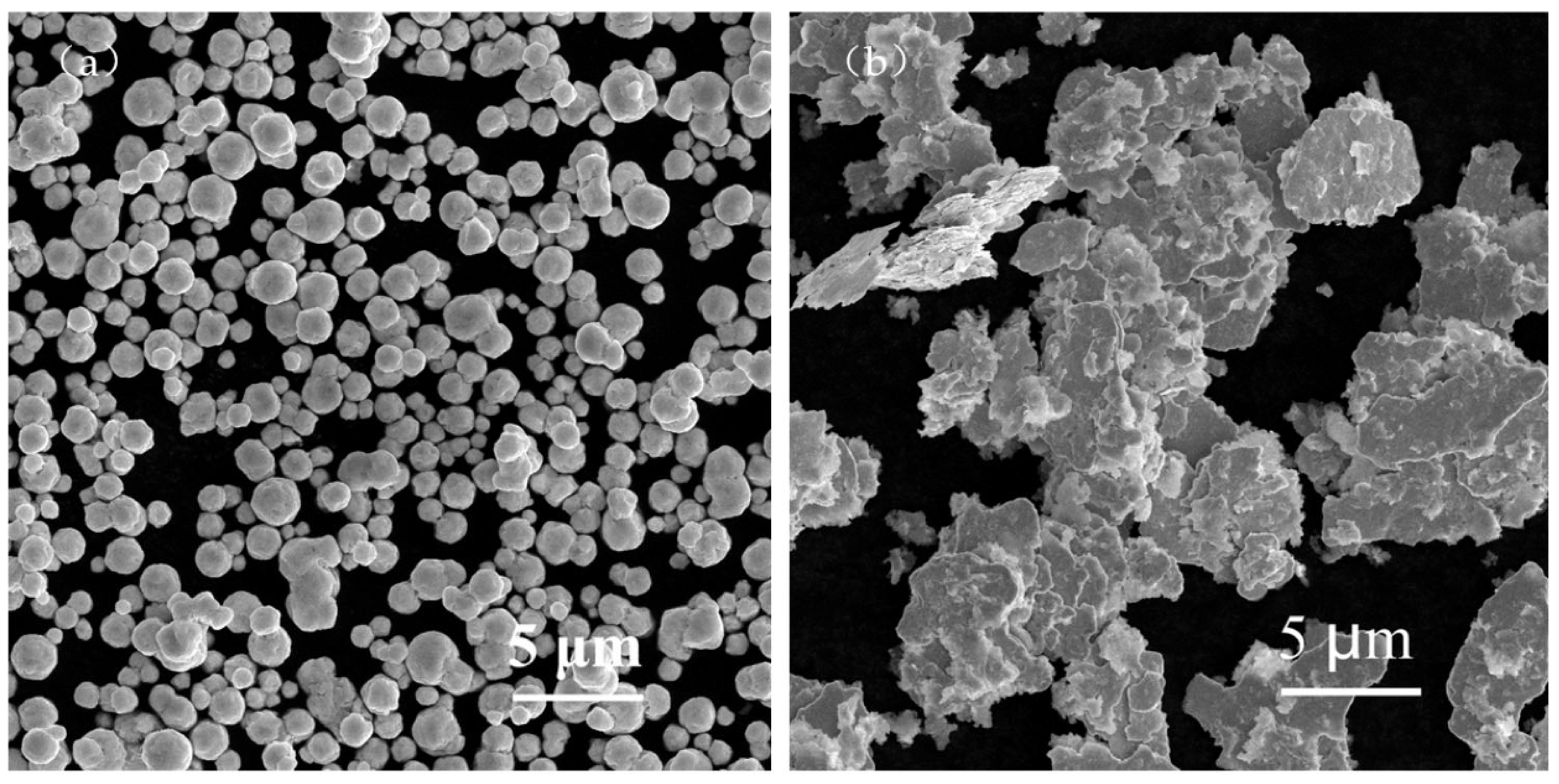

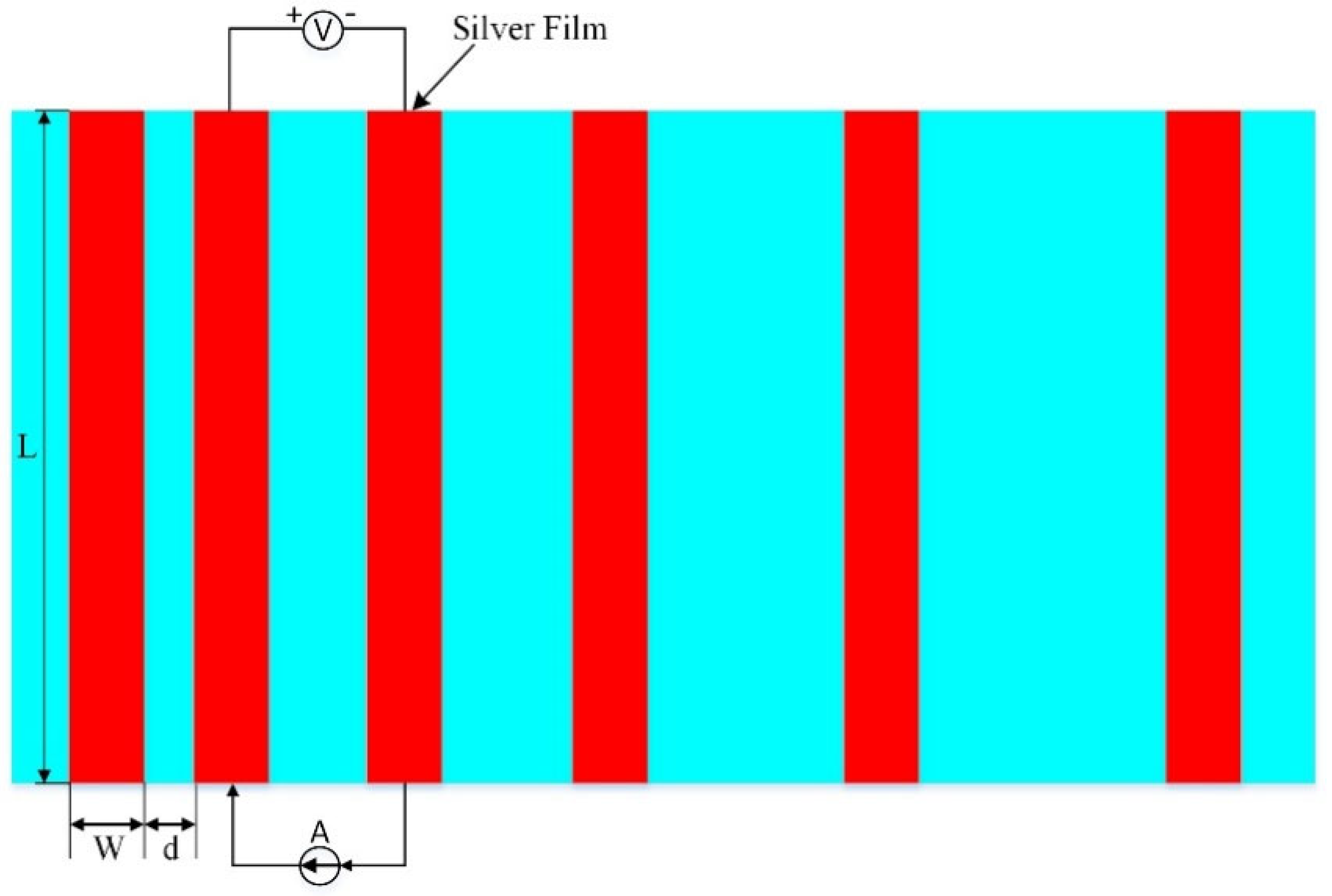



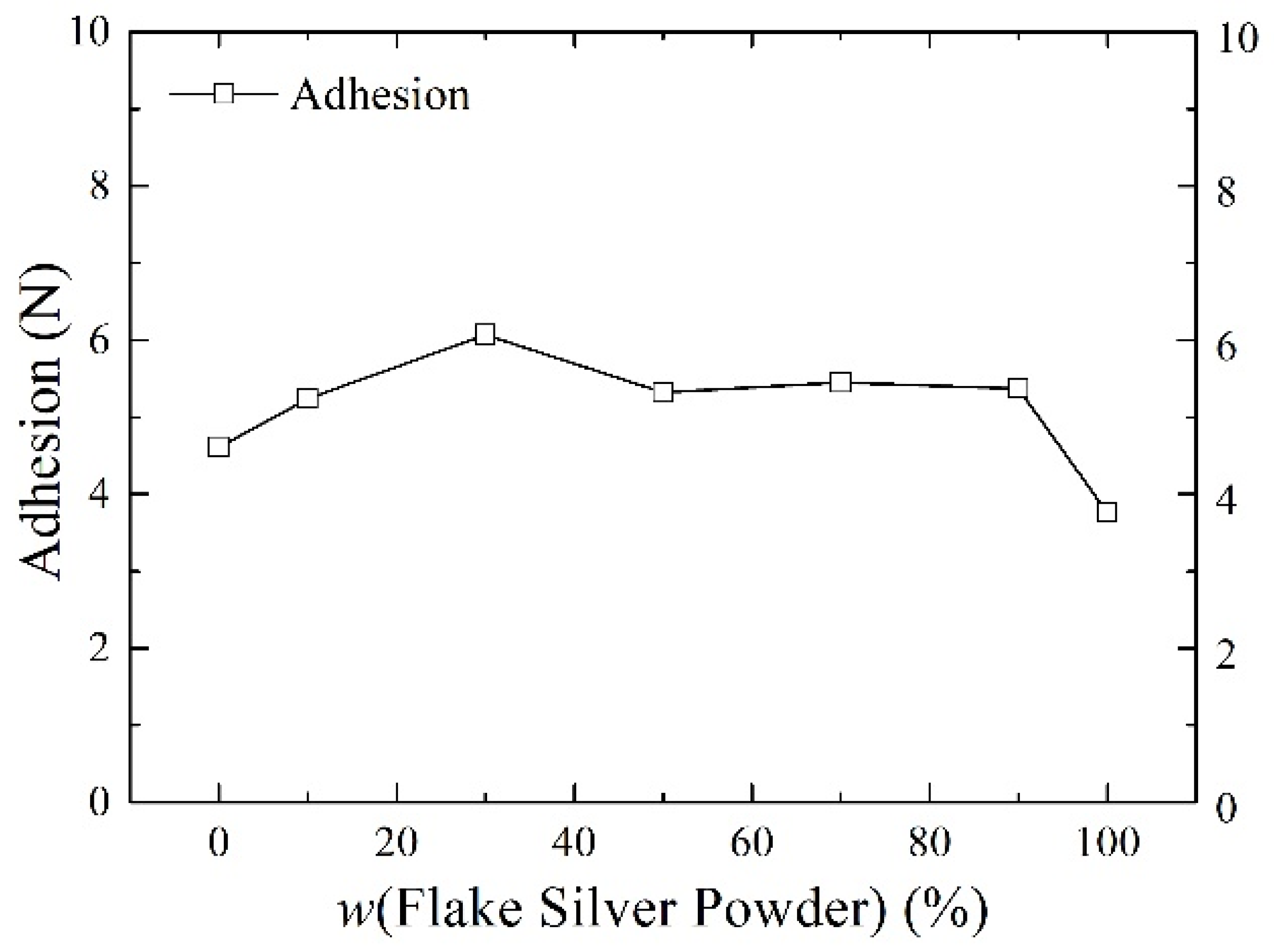
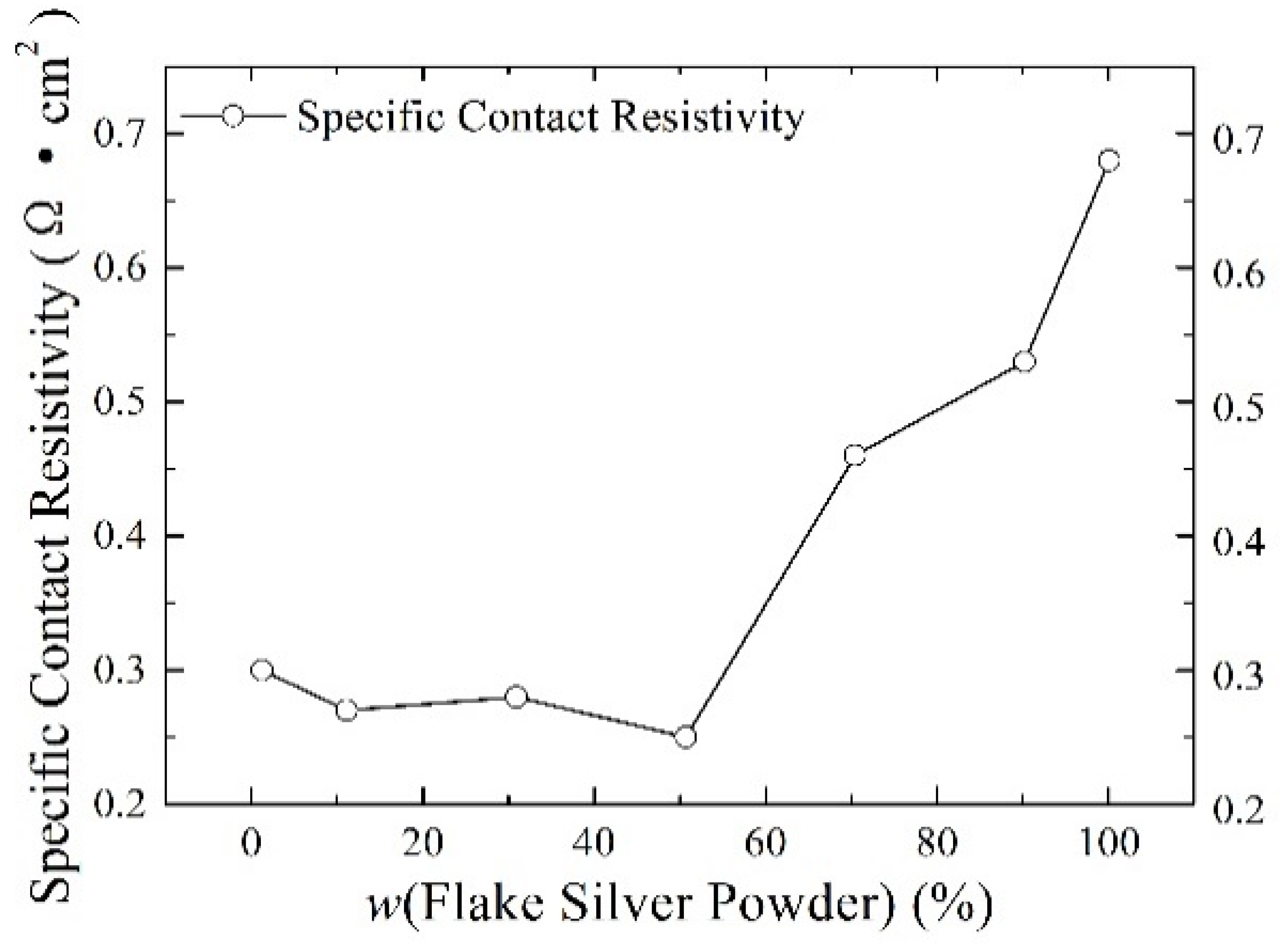
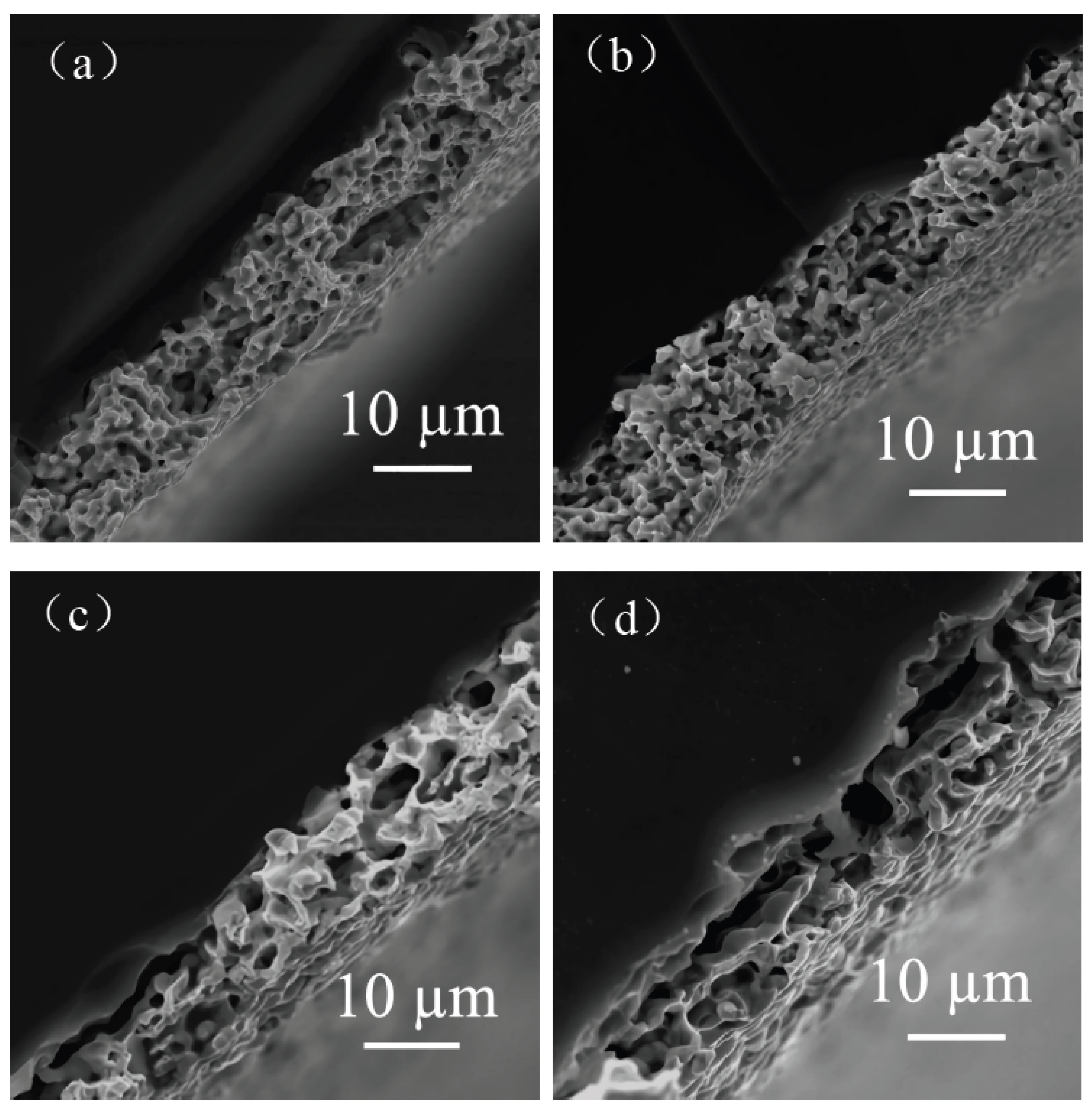
Publisher’s Note: MDPI stays neutral with regard to jurisdictional claims in published maps and institutional affiliations. |
© 2022 by the authors. Licensee MDPI, Basel, Switzerland. This article is an open access article distributed under the terms and conditions of the Creative Commons Attribution (CC BY) license (https://creativecommons.org/licenses/by/4.0/).
Share and Cite
Li, W.; Yu, C.; Wang, Y.; Yao, Y.; Yu, X.; Zuo, C.; Yu, Y. Experimental Investigation of Effect of Flake Silver Powder Content on Sintering Structure and Properties of Front Silver Paste of Silicon Solar Cell. Materials 2022, 15, 7142. https://doi.org/10.3390/ma15207142
Li W, Yu C, Wang Y, Yao Y, Yu X, Zuo C, Yu Y. Experimental Investigation of Effect of Flake Silver Powder Content on Sintering Structure and Properties of Front Silver Paste of Silicon Solar Cell. Materials. 2022; 15(20):7142. https://doi.org/10.3390/ma15207142
Chicago/Turabian StyleLi, Wei, Chunxiu Yu, Yunkai Wang, Yuan Yao, Xianglei Yu, Chuan Zuo, and Yang Yu. 2022. "Experimental Investigation of Effect of Flake Silver Powder Content on Sintering Structure and Properties of Front Silver Paste of Silicon Solar Cell" Materials 15, no. 20: 7142. https://doi.org/10.3390/ma15207142




